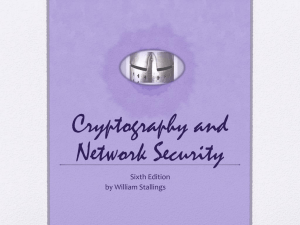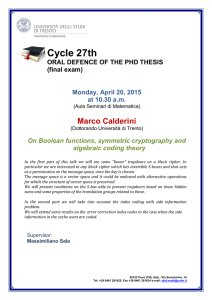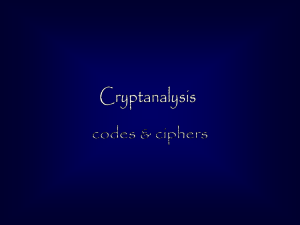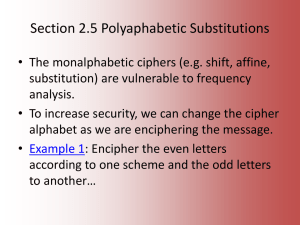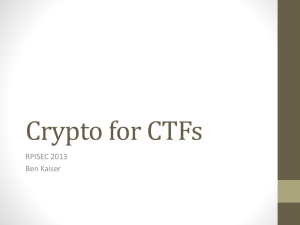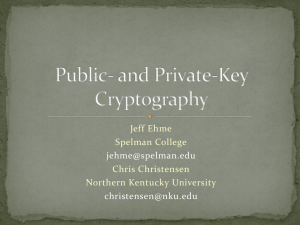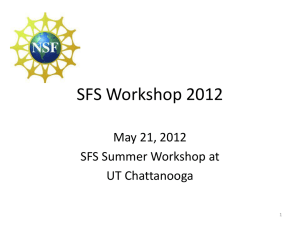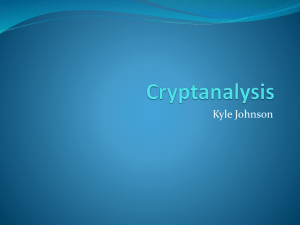Chapter 2-3
advertisement
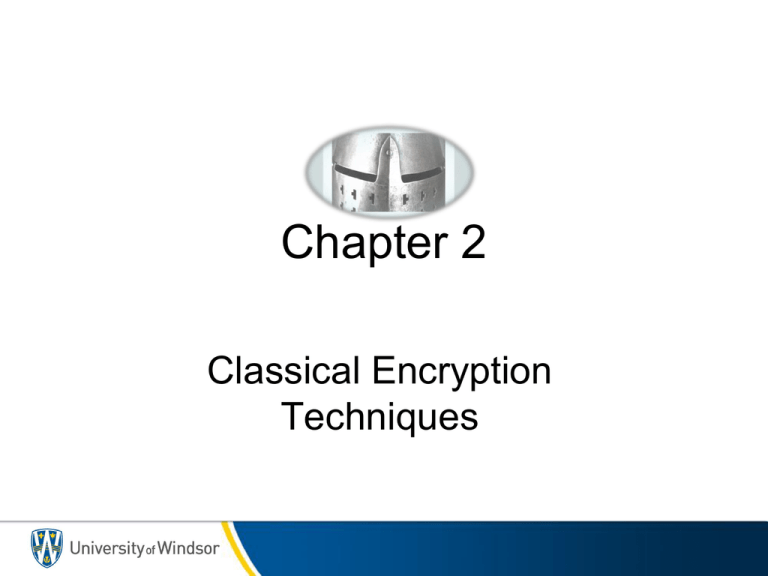
Chapter 2 Classical Encryption Techniques "I am fairly familiar with all the forms of secret writings, and am myself the author of a trifling monograph upon the subject, in which I analyze one hundred and sixty separate ciphers," said Holmes. —The Adventure of the Dancing Men, Sir Arthur Conan Doyle Symmetric Encryption • Also referred to as conventional encryption or single-key encryption • Was the only type of encryption in use prior to the development of public-key encryption in the 1970s • Remains by far the most widely used of the two types of encryption Basic Terminology • Plaintext • The original message • Ciphertext • The coded message • Enciphering or encryption • Process of converting from plaintext to ciphertext • Deciphering or decryption • Restoring the plaintext from the ciphertext • Cryptography • Study of encryption • Cryptographic system or cipher • Schemes used for encryption • Cryptanalysis • Techniques used for deciphering a message without any knowledge of the enciphering details • Cryptology • Areas of cryptography and cryptanalysis together Simplified Model of Symmetric Encryption Model of Symmetric Cryptosystem Cryptographic Systems • Characterized along three independent dimensions: The type of operations used for transforming plaintext to ciphertext The number of keys used The way in which the plaintext is processed Substitution Symmetric, single-key, secret-key, conventional encryption Block cipher Transposition Asymmetric, two-key, or public-key encryption Stream cipher Cryptanalysis and Brute-Force Attack Cryptanalysis Brute-force attack • Attack relies on the nature of the algorithm plus some knowledge of the general characteristics of the plaintext • Attack exploits the characteristics of the algorithm to attempt to deduce a specific plaintext or to deduce the key being used • Attacker tries every possible key on a piece of ciphertext until an intelligible translation into plaintext is obtained • On average, half of all possible keys must be tried to achieve success Table 2.1 Types of Attacks on Encrypted Messages Encryption Scheme Security • Unconditionally secure • No matter how much time an opponent has, it is impossible for him or her to decrypt the ciphertext simply because the required information is not there • Computationally secure • The cost of breaking the cipher exceeds the value of the encrypted information • The time required to break the cipher exceeds the useful lifetime of the information Brute-Force Attack Involves trying every possible key until an intelligible translation of the ciphertext into plaintext is obtained On average, half of all possible keys must be tried to achieve success To supplement the brute-force approach, some degree of knowledge about the expected plaintext is needed, and some means of automatically distinguishing plaintext from garble is also needed Substitution Technique • Is one in which the letters of plaintext are replaced by other letters or by numbers or symbols • If the plaintext is viewed as a sequence of bits, then substitution involves replacing plaintext bit patterns with ciphertext bit patterns Caesar Cipher • Simplest and earliest known use of a substitution cipher (used by Julius Caesar) • Involves replacing each letter of the alphabet with the letter standing three places further down the alphabet • Alphabet is wrapped around so that the letter following Z is A plain: MEET ME AFTER THE TOGA PARTY cipher: PHHW PH DIWHU WKH WRJD SDUWB Caesar Cipher Algorithm • Can define transformation as: a b c d e f g h i j k l m n o p q r s t u v w x y z D E F G H I J K L M N O P Q R S T U V W X Y Z A B C • Mathematically give each letter a number a b c d e f g h i j k l m n o p q r s t u v w x y z 0 1 2 3 4 5 6 7 8 9 10 11 12 13 14 15 16 17 18 19 20 21 22 23 24 25 • Algorithm can be expressed as: c = E(3, p) = (p + 3) mod (26) • A shift may be of any amount, so that the general Caesar algorithm is: C = E(k , p ) = (p + k ) mod 26 • Where k takes on a value in the range 1 to 25; the decryption algorithm is simply: p = D(k , C ) = (C - k ) mod 26 Brute-Force Cryptanalysis of Caesar Cipher (This chart can be found on page 35 in the textbook) Sample of Compressed Text Monoalphabetic Cipher • Permutation – Of a finite set of elements S is an ordered sequence of all the elements of S , with each element appearing exactly once – If the “cipher” line can be any permutation of the 26 alphabetic characters, then there are 26! or greater than 4 x 1026 possible keys – This is 10 orders of magnitude greater than the key space for DES – Approach is referred to as a monoalphabetic substitution cipher because a single cipher alphabet is used per message Monoalphabetic Ciphers • Easy to break because they reflect the frequency data of the original alphabet • Countermeasure is to provide multiple substitutes (homophones) for a single letter • Digram – Two-letter combination – Most common is th • Trigram – Three-letter combination – Most frequent is the Playfair Cipher • Best-known multiple-letter encryption cipher • Treats digrams in the plaintext as single units and translates these units into ciphertext digrams • Based on the use of a 5 x 5 matrix of letters constructed using a keyword • Invented by British scientist Sir Charles Wheatstone in 1854 • Used as the standard field system by the British Army in World War I and the U.S. Army and other Allied forces during World War II Playfair Key Matrix • Fill in letters of keyword (minus duplicates) from left to right and from top to bottom, then fill in the remainder of the matrix with the remaining letters in alphabetic order • Using the keyword MONARCHY: • Example: M O N A R • Youtube: C H Y B D E F G I/J K L P Q S T U V W X Z Hill Cipher • Developed by the mathematician Lester Hill in 1929 • Strength is that it completely hides single-letter frequencies – The use of a larger matrix hides more frequency information – A 3 x 3 Hill cipher hides not only single-letter but also twoletter frequency information • Strong against a ciphertext-only attack but easily broken with a known plaintext attack • Example: Polyalphabetic Ciphers • Polyalphabetic substitution cipher – Improves on the simple monoalphabetic technique by using different monoalphabetic substitutions as one proceeds through the plaintext message All these techniques have the following features in common: • A set of related monoalphabetic substitution rules is used • A key determines which particular rule is chosen for a given transformation Vigenère Cipher • Best known and one of the simplest polyalphabetic substitution ciphers • In this scheme the set of related monoalphabetic substitution rules consists of the 26 Caesar ciphers with shifts of 0 through 25 • Each cipher is denoted by a key letter which is the ciphertext letter that substitutes for the plaintext letter a Example of Vigenère Cipher • To encrypt a message, a key is needed that is as long as the message • Usually, the key is a repeating keyword • For example, if the keyword is deceptive, the message “we are discovered save yourself” is encrypted as: key: deceptivedeceptivedeceptive plaintext: wearediscoveredsaveyourself ciphertext: ZICVTWQNGRZGVTWAVZHCQYGLMGJ Vigenère Autokey System • A keyword is concatenated with the plaintext itself to provide a running key • Example: key: deceptivewearediscoveredsav plaintext: wearediscoveredsaveyourself ciphertext: ZICVTWQNGKZEIIGASXSTSLVVWLA • Even this scheme is vulnerable to cryptanalysis – Because the key and the plaintext share the same frequency distribution of letters, a statistical technique can be applied Vernam Cipher • The ultimate defense against such a cryptanalysis is to choose a keyword that is as long as the plaintext and has no statistical relationship to it. • Such a system was introduced by an AT&T engineer named Gilbert Vernam in 1918. His system works on binary data (bits) rather than letters. • The essence of this technique is the means of construction of the key. Vernam proposed the use of a running loop of tape that eventually repeated the key, so that in fact the system worked with a very long but repeating keyword. Although such a scheme, with a long key, presents formidable cryptanalytic difficulties, it • can be broken with sufficient ciphertext, the use of known or probable plaintext sequences, or both. Vernam Cipher One-Time Pad • Improvement to Vernam cipher proposed by an Army Signal Corp officer, Joseph Mauborgne • Use a random key that is as long as the message so that the key need not be repeated • Key is used to encrypt and decrypt a single message and then is discarded • Each new message requires a new key of the same length as the new message • Scheme is unbreakable – Produces random output that bears no statistical relationship to the plaintext – Because the ciphertext contains no information whatsoever about the plaintext, there is simply no way to break the code Difficulties • The one-time pad offers complete security but, in practice, has two fundamental difficulties: – There is the practical problem of making large quantities of random keys • Any heavily used system might require millions of random characters on a regular basis – Mammoth key distribution problem • For every message to be sent, a key of equal length is needed by both sender and receiver • Because of these difficulties, the one-time pad is of limited utility – Useful primarily for low-bandwidth channels requiring very high security • The one-time pad is the only cryptosystem that exhibits perfect secrecy (see Appendix F) Rail Fence Cipher • Simplest transposition cipher • Plaintext is written down as a sequence of diagonals and then read off as a sequence of rows • To encipher the message “meet me after the toga party” with a rail fence of depth 2, we would write: m e m a t r h t g p r y e t e f e t e o a a t Encrypted message is: MEMATRHTGPRYETEFETEOAAT Row Transposition Cipher • Is a more complex transposition • Write the message in a rectangle, row by row, and read the message off, column by column, but permute the order of the columns – The order of the columns then becomes the key to the algorithm Key: 4 3 1 2 5 6 7 Plaintext: a t t a c k p o s t p o n e d u n t i l t w o a m x y z Ciphertext: TTNAAPTMTSUOAODWCOIXKNLYPETZ Rotor Machines Steganography Other Steganography Techniques • Character marking • Selected letters of printed or typewritten text are over-written in pencil • The marks are ordinarily not visible unless the paper is held at an angle to bright light • Invisible ink • A number of substances can be used for writing but leave no visible trace until heat or some chemical is applied to the paper • Typewriter correction ribbon • Used between lines typed with a black ribbon, the results of typing with the correction tape are visible only under a strong light • Pin punctures • Small pin punctures on selected letters are ordinarily not visible unless the paper is held up in front of a light Summary • Symmetric Cipher Model – Cryptography – Cryptanalysis and Brute-Force Attack • Transposition techniques • Rotor machines • Substitution techniques – Caesar cipher – Monoalphabetic ciphers – Playfair cipher – Hill cipher – Polyalphabetic ciphers – One-time pad • Steganography Chapter 3 Block Ciphers and the Data Encryption Standard “All the afternoon Mungo had been working on Stern's code, principally with the aid of the latest messages which he had copied down at the Nevin Square drop. Stern was very confident. He must be well aware London Central knew about that drop. It was obvious that they didn't care how often Mungo read their messages, so confident were they in the impenetrability of the code.” —Talking to Strange Men, Ruth Rendell Stream Cipher Encrypts a digital data stream one bit or one byte at a time Examples: • Autokeyed Vigenère cipher • Vernam cipher In the ideal case a onetime pad version of the Vernam cipher would be used, in which the keystream is as long as the plaintext bit stream For practical reasons the bit-stream generator must be implemented as an algorithmic procedure so that the cryptographic bit stream can be produced by both users If the cryptographic keystream is random, then this cipher is unbreakable by any means other than acquiring the keystream It must be computationally impractical to predict future portions of the bit stream based on previous portions of the bit stream • Keystream must be provided to both users in advance via some independent and secure channel • This introduces insurmountable logistical problems if the intended data traffic is very large The two users need only share the generating key and each can produce the keystream Block Cipher A block of plaintext is treated as a whole and used to produce a ciphertext block of equal length Typically a block size of 64 or 128 bits is used As with a stream cipher, the two users share a symmetric encryption key The majority of network-based symmetric cryptographic applications make use of block ciphers Stream Cipher and Block Cipher Table 3.1 Encryption and Decryption Tables for Substitution Cipher of Fig 3.2 Feistel Cipher • Proposed the use of a cipher that alternates substitutions and permutations Substitutions • Each plaintext element or group of elements is uniquely replaced by a corresponding ciphertext element or group of elements Permutation • No elements are added or deleted or replaced in the sequence, rather the order in which the elements appear in the sequence is changed – Is a practical application of a proposal by Claude Shannon to develop a product cipher that alternates confusion and diffusion functions – Is the structure used by many significant symmetric block ciphers currently in use Diffusion and Confusion • Terms introduced by Claude Shannon to capture the two basic building blocks for any cryptographic system – Shannon’s concern was to thwart cryptanalysis based on statistical analysis Diffusion • The statistical structure of the plaintext is dissipated into long-range statistics of the ciphertext • This is achieved by having each plaintext digit affect the value of many ciphertext digits Confusion • Seeks to make the relationship between the statistics of the ciphertext and the value of the encryption key as complex as possible • Even if the attacker can get some handle on the statistics of the ciphertext, the way in which the key was used to produce that ciphertext is so complex as to make it difficult to deduce the key Feistel Cipher Structure Feistel Cipher Design Features • Block size – Larger block sizes mean greater security but reduced encryption/decryption speed for a given algorithm • Key size • – Greater complexity generally means greater resistance to cryptanalysis • – Larger key size means greater security but may decrease encryption/decryption speeds • • Subkey generation algorithm – Greater complexity in this algorithm should lead to greater difficulty of cryptanalysis Fast software encryption/decryption – In many cases, encrypting is embedded in applications or utility functions in such a way as to preclude a hardware implementation; accordingly, the speed of execution of the algorithm becomes a concern Number of rounds – The essence of the Feistel cipher is that a single round offers inadequate security but that multiple rounds offer increasing security Round function F • Ease of analysis – If the algorithm can be concisely and clearly explained, it is easier to analyze that algorithm for cryptanalytic vulnerabilities and therefore develop a higher level of assurance as to its strength Feistel Example Data Encryption Standard (DES) • Issued in 1977 by the National Bureau of Standards (now NIST) as Federal Information Processing Standard 46 • Was the most widely used encryption scheme until the introduction of the Advanced Encryption Standard (AES) in 2001 • Algorithm itself is referred to as the Data Encryption Algorithm (DEA) – Data are encrypted in 64-bit blocks using a 56-bit key – The algorithm transforms 64-bit input in a series of steps into a 64-bit output – The same steps, with the same key, are used to reverse the encryption DES Encryption Algorithm Table 3.2 DES Example (Table can be found on page 75 in textbook) Note: DES subkeys are shown as eight 6-bit values in hex format Table 3.3 Avalanche Effect in DES: Change in Plaintext Table 3.4 Avalanche Effect in DES: Change in Key Table 3.5: Average Time Required for Exhaustive Key Search Strength of DES • Timing attacks – One in which information about the key or the plaintext is obtained by observing how long it takes a given implementation to perform decryptions on various ciphertexts – Exploits the fact that an encryption or decryption algorithm often takes slightly different amounts of time on different inputs – So far it appears unlikely that this technique will ever be successful against DES or more powerful symmetric ciphers such as triple DES and AES Block Cipher Design Principles: Number of Rounds The greater the number of rounds, the more difficult it is to perform cryptanalysis In general, the criterion should be that the number of rounds is chosen so that known cryptanalytic efforts require greater effort than a simple brute-force key search attack If DES had 15 or fewer rounds, differential cryptanalysis would require less effort than a brute-force key search Feistel Example Block Cipher Design Principles: Design of Function F • The heart of a Feistel The algorithm should have block cipher is the good avalanche properties function F • The more nonlinear F, Strict Bit the more difficult any avalanche independence type of cryptanalysis criterion (SAC) criterion (BIC) will be States that output States that any output • The SAC and BIC bits j and k should bit j of an S-box change should change with criteria appear to independently when probability 1/2 when any single input bit i any single input bit i strengthen the is inverted for all i , j, is inverted for all i , j and k effectiveness of the confusion function Block Cipher Design Principles: Key Schedule Algorithm • With any Feistel block cipher, the key is used to generate one subkey for each round • In general, we would like to select subkeys to maximize the difficulty of deducing individual subkeys and the difficulty of working back to the main key • It is suggested that, at a minimum, the key schedule should guarantee key/ciphertext Strict Avalanche Criterion and Bit Independence Criterion Summary • Traditional Block Cipher Structure – Stream ciphers – Block ciphers – Feistel cipher • The Data Encryption Standard (DES) – Encryption – Decryption – Avalanche effect • The strength of DES – Use of 56-bit keys – Nature of the DES algorithm – Timing attacks • Block cipher design principles – – – – DES design criteria Number of rounds Design of function F Key schedule algorithm
